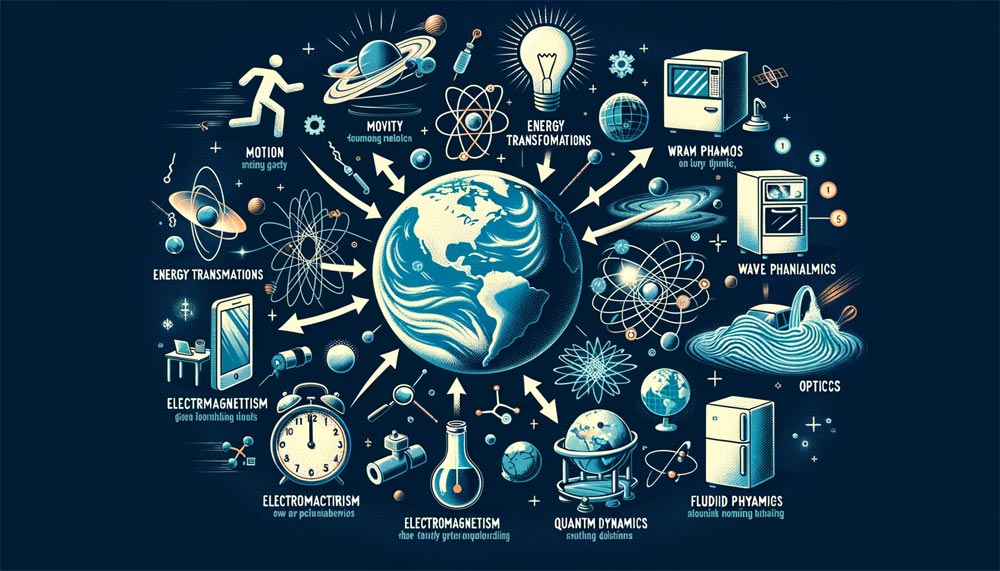
Physics in Everyday Life: Unseen Forces Shaping Our World
Introduction
The physical world, in all its grandeur and complexity, is governed by the laws of physics. Many dismiss it as a subject limited to classrooms or laboratories, but its principles and concepts permeate our daily life. This article unveils the fascinating interplay of physics in our day-to-day activities, shedding light on the invisible forces that shape our existence.
Definition and Branches of Physics
Physics, often termed as the science of matter and energy, is the study of the fundamental principles that govern the universe. The discipline is vast and can be divided into various branches:
- Classical Mechanics: Focuses on the physical laws related to motion.
- Quantum Physics: Explores the behavior of matter and energy on the atomic and subatomic scales.
- Thermodynamics: Concerned with heat transfer and energy transformations.
- Electromagnetism: Studies electric and magnetic forces and fields.
Understanding each branch is essential to grasp the full spectrum of physics' impact on our lives.
How Physics Affects Our Daily Life?
-
Gravity's Ubiquity:
- Keeps us grounded on Earth.
- Causes objects to fall.
- Governs planetary orbits and the tides.
-
Laws of Motion:
- Dictate how vehicles move on roads.
- Explain the movement of pendulum clocks.
- Describe how athletes perform various sports.
-
Energy Transformations:
- Allow us to generate electricity (e.g., via hydroelectric dams or solar panels).
- Dictate the efficiency of our vehicles.
- Enable the conversion of food into energy in our bodies.
-
Wave Phenomena:
- Underlie the working of musical instruments.
- Explain rainbows and the dispersion of light.
- Are the reason we can hear sounds.
-
Electromagnetism:
- Powers our electronic devices.
- Enables wireless communication (Wi-Fi, cellular networks).
- Operates electric trains and trams.
-
Thermal Dynamics:
- Explain why ice melts and water evaporates.
- Dictate the efficiency of home insulation.
- Describe the cooling mechanism of refrigerators.
-
Optics:
- Facilitate our vision and the working of our eyes.
- Govern cameras, telescopes, and microscopes.
- Explain phenomena like mirages and the twinkling of stars.
-
Quantum Physics:
- Drive the technology behind modern electronics like semiconductors.
- Enable lasers used in surgeries and DVDs.
- Describe the behavior of materials at nano-level.
-
Fluid Dynamics:
- Explain the flow of blood in our veins.
- Describe how ships float and planes fly.
- Govern the behavior of weather patterns.
-
Relativity:
- Essential for the accuracy of GPS systems.
- Describes the behavior of fast-moving objects (like satellites).
- Predicts phenomena like time dilation.
Everyday Examples of Physics Principles
Whether you're dropping a pen or using your smartphone, you're experiencing the principles of physics. Here are some everyday examples:
- Gravity: The reason why things fall and stay anchored to the ground.
- Motion: The way cars move, children swing, or planets orbit; all are governed by the laws of motion.
- Energy: Every time you cook, turn on a light, or pedal a bicycle, you are either consuming or converting energy.
These examples illustrate how deeply principles of physics in everyday life are embedded in our daily actions.
Physics in Modern Technology
With technological advancements, the role of physics has become even more profound:
- Smartphones: Rely on quantum physics. The semiconductors enabling your device's functionality operate based on quantum principles.
- Transportation: Whether it's the aerodynamics of cars or the propulsion of rockets, classical mechanics plays a crucial role.
- MRI Machines: Utilize principles from both quantum physics and electromagnetism to create detailed images of the human body.
This intertwining of technology and physics shows the practical applications of physics concepts in the modern age.
Physics in Household Tasks
At home, physics isn't just a topic of discussion but an active participant:
- Cooking: Heat transfer, a concept from thermodynamics, ensures your food gets cooked evenly.
- Heating: The laws of nature govern how your home remains warm during winters.
- Lighting: The principles of electromagnetism allow us to harness electricity for lighting up our homes.
Indeed, the role of thermodynamics in household tasks is pervasive, impacting almost every facet of our domestic lives.
A Historical Perspective
Physics wasn't always as refined or as understood as it is today. Historically:
- Ancient civilizations had rudimentary understandings of forces and motions.
- The Renaissance period saw a surge in scientific inquiry, setting the stage for modern physics.
- Pioneers like Newton and Einstein revolutionized our understanding, making complex concepts relatable to the masses.
This evolution, as Stephen Hawking beautifully encapsulates in "A Brief History of Time," illustrates how our understanding of physics has continually shaped and been shaped by our daily lives.
In Conclusion
As Richard Feynman aptly put it, “Physics is like sex: sure, it may give some practical results, but that's not why we do it.” Our exploration of the physical science realm isn't merely for tangible technological progress but for a deeper understanding and appreciation of the universe. Every action, from the mundane to the extraordinary, echoes the laws of nature and their profound impact on our existence.
So, the next time you marvel at the latest tech gadget or wonder about the magic behind simple household tasks, remember the unseen world of physics working tirelessly behind the scenes. Embrace this knowledge, share it, and foster a deeper connection with the world around you.
Recommended Reads and References:
- Feynman, R. P. (1965). The character of physical law. MIT press.
- Walker, J. (1977). The Flying Circus of Physics. Wiley.
- Hawking, S. (1988). A Brief History of Time. Bantam Books.
- Websites like Physics.org and the American Physical Society offer invaluable insights into the myriad ways physics touches our lives daily.




